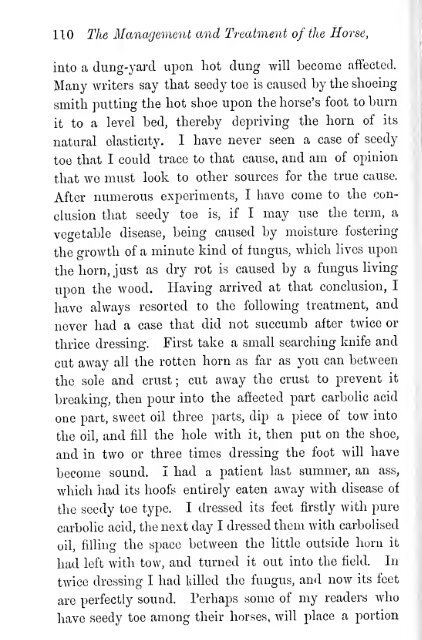The management and treatment of the horse in the stable, field, and ...
The management and treatment of the horse in the stable, field, and ...
The management and treatment of the horse in the stable, field, and ...
You also want an ePaper? Increase the reach of your titles
YUMPU automatically turns print PDFs into web optimized ePapers that Google loves.
110 <strong>The</strong> Management <strong>and</strong> Treatment <strong>of</strong> <strong>the</strong> Horse,<br />
<strong>in</strong>to a dung-yard upon hot dung will become affected.<br />
Many writers say that seedy toe is caused by <strong>the</strong> shoe<strong>in</strong>g<br />
smith putt<strong>in</strong>g <strong>the</strong> hot shoe upon <strong>the</strong> <strong>horse</strong>'s foot to burn<br />
it to a level bed, <strong>the</strong>reby depriv<strong>in</strong>g <strong>the</strong> horn <strong>of</strong> its<br />
natural elasticity. I have never seen a case <strong>of</strong> seedy<br />
toe that I could trace to that cause, <strong>and</strong> am <strong>of</strong> op<strong>in</strong>ion<br />
that we must look to o<strong>the</strong>r sources for <strong>the</strong> true cause.<br />
After numerous experiments, I have come to <strong>the</strong> con-<br />
clusion that seedy toe is, if I may use <strong>the</strong> term, a<br />
vegetable disease, be<strong>in</strong>g caused by moisture foster<strong>in</strong>g<br />
<strong>the</strong> growth <strong>of</strong> a m<strong>in</strong>ute k<strong>in</strong>d <strong>of</strong> fungus, which lives upon<br />
<strong>the</strong> horn, just as dry rot is caused by a fungus liv<strong>in</strong>g<br />
upon <strong>the</strong> wood. Hav<strong>in</strong>g arrived at that conclusion, I<br />
have always resorted to <strong>the</strong> follow<strong>in</strong>g <strong>treatment</strong>, <strong>and</strong><br />
never had a case that did not succumb after twice or<br />
thrice dress<strong>in</strong>g. First take a small search<strong>in</strong>g knife <strong>and</strong><br />
cut away all <strong>the</strong> rotten horn as far as you can between<br />
<strong>the</strong> sole <strong>and</strong> crust; cut away <strong>the</strong> crust to prevent it<br />
break<strong>in</strong>g, <strong>the</strong>n pour <strong>in</strong>to <strong>the</strong> affected part carbolic acid<br />
one part, sweet oil three parts, dip a piece <strong>of</strong> tow <strong>in</strong>to<br />
<strong>the</strong> oil, <strong>and</strong> fill <strong>the</strong> hole with it, <strong>the</strong>n put on <strong>the</strong> shoe,<br />
<strong>and</strong> <strong>in</strong> two or three times dress<strong>in</strong>g <strong>the</strong> foot will have<br />
become sound. I had a patient last summer, an ass,<br />
which had its ho<strong>of</strong>s entirely eaten away with disease <strong>of</strong><br />
<strong>the</strong> seedy toe type. I dressed its feet firstly with pure<br />
carbolic acid, <strong>the</strong> next day I dressed <strong>the</strong>m with carbolised<br />
oil, fill<strong>in</strong>g <strong>the</strong> space between <strong>the</strong> little outside horn it<br />
had left with tow, <strong>and</strong> turned it out <strong>in</strong>to <strong>the</strong> <strong>field</strong>. In<br />
twice dress<strong>in</strong>g I had lulled <strong>the</strong> fungus, <strong>and</strong> now its feet<br />
are perfectly sound. Perhaps some <strong>of</strong> my readers who<br />
have seedy toe among <strong>the</strong>ir <strong>horse</strong>s, will place a portion
















